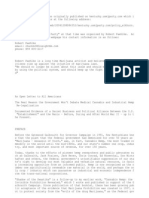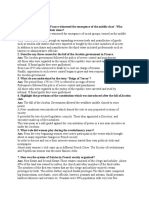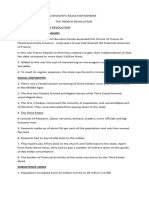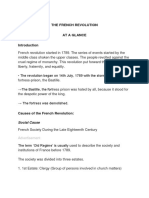Concordant With Church But Church Interfernce in National and Political Matters Restricted
Concordant With Church But Church Interfernce in National and Political Matters Restricted
Uploaded by
Animesh SinghCopyright:
Available Formats
Concordant With Church But Church Interfernce in National and Political Matters Restricted
Concordant With Church But Church Interfernce in National and Political Matters Restricted
Uploaded by
Animesh SinghOriginal Description:
Original Title
Copyright
Available Formats
Share this document
Did you find this document useful?
Is this content inappropriate?
Copyright:
Available Formats
Concordant With Church But Church Interfernce in National and Political Matters Restricted
Concordant With Church But Church Interfernce in National and Political Matters Restricted
Uploaded by
Animesh SinghCopyright:
Available Formats
Concordant with church but church interfernce in national and political matters restricted
Specically the
French government would appoint bishops, but the bishops would appoint parish
priests. The concordat gained Napoleon the support of the organized church as well
as the ma jority of the French people
Napoleon thought that his greatest work was his comprehensive system of
laws,
known as the Napoleonic Code. Although the code gave the country a
uniform set
of laws and eliminated many injustices, it actually limited liberty and promoted
order
and authority over individual rights. The code took away some rights that
women had
won during the Revolution, such as the right to sell their property. reedom
of speech
and of the press, also established during the Revolution, were restricted
rather than
e!panded. The new laws also restored slavery in the rench colonies of the
Caribbean, which the revolutionary government had abolished.
The Romantic "ovement
At the beginning of the #$th century, the %nlightenment idea of reason
gradually gave
way to another major movement& romanticism. Romanticism was a movement in
art
and ideas. 't showed deep interest both in nature and in the thoughts and
feelings of
the individual. 'n many ways, romantic thinkers and writers reacted against
the ideals
of the %nlightenment. Romantics rejected the rigidly ordered world of the
middle(
class. They turned from reason to emotion, from society to
nature. Nationalism also
red the romantic imagination. For
e!ample, a
ghter for freedom in reece, !ord "yron also
ranked as one of the leading romantic poets of the time
The 'deas of Romanticism %motion, sometimes wild emo(
tion, was a key element of romanticism. Nevertheless, romanti(
cism went beyond feelings. Romantics e!pressed a wide range
of ideas and attitudes. 'n general, romantic thinkers and artists
emphasized inner feelings, emotions, imagination
focused on the mysterious and the supernatural# also,
on the odd, e!otic, and grotes)ue or horrifying
loved the beauties of untamed nature
idealized the past as a simpler and nobler time
gloried heroes and heroic actions
cherished fol$ traditions, music, and stories
valued the common people and the individual
promoted radical change and democracy
*nioni+ation and ,egislative Reform
actory workers faced long hours, dirty and dangerous working conditions,
and the
threat of being laid off. -y the #.//s, working people became more active in
politics.
To press for reforms, workers joined together in voluntary associations
called unions.
The *nion "ovement A union spoke for all the workers in a particular trade.
*nions engaged in collective bargaining
negotiations between wor$ers and their
employers. They bargained for better working conditions and higher pay. 'f
factory
owners refused these demands, union members could strike, or refuse to
work.
0killed workers led the way in forming unions because their special skills gave
them e!tra bargaining power. "anagement would have trouble replacing such
skilled
workers as carpenters, printers, and spinners. Thus the earliest unions helped
the
lower middle class more than they helped the poorest workers.
The union movement underwent slow, painful growth in both 1reat -ritain and
the *nited 0tates. or years, the -ritish government denied workers the
right to form
unions. The government saw unions as a threat to social order and stability.
'ndeed,
the Combination Acts of #2$$ and #.// outlawed unions and strikes. -ravely
ignoring
the threat of jail or job loss, factory workers joined unions anyway.
3arliament
nally
repealed the Combination Acts in #.45. After #.46, the -ritish government
unhappily
tolerated unions.
-ritish unions had shared goals of raising wages and improving working
conditions.
-y #.26, -ritish trade unions had won the right to strike and picket
peacefully. They
had also built up a membership of about # million people.
'n the *nited 0tates, skilled workers had belonged to unions since the early
#.//s. 'n
#..7, several unions joined together to form the organi+ation that would
become the
American ederation of ,abor
8A,9. A series of successful
strikes won A, members higher
wages and shorter hours.
Reform ,aws 'n both 1reat
-ritain and the *nited 0tates,
new laws reformed some of the
worst abuses of industriali+ation.
'n #.:4, for e!ample, 3arliament
set up a committee to investigate
child labor. As a result of this
committee;
s
ndings, %arliament
passed the actory Act of #.::.
The new law made it illegal to
hire children under $ years old.
Children from the ages of $ to #4
could not work more than . hours
a day. <oung people from #: to #2
could not work more than #4 hours. 'n #.54 the "ines Act prevented women
and children from working underground.
'n #.52, the 3arliament passed a bill that helped working women as well as
their children. The Ten =ours Act of #.52 limited the workday to ten hours
for
women and children who worked in factories.
Reformers in the *nited 0tates also passed legislation to protect child
workers.
'n #$/5, a group of progressive reformers organi+ed the National Child ,abor
Committee to end child labor. Arguing that child labor lowered wages for all
workers,
labor union members joined the reformers. Together these groups pressured
national
and state politicians to ban child labor and set ma!imum working hours. The
0upreme
Court in #$#$ had objected to a federal child labor law. =owever, it did allow
individual
states to legally limit the working hours of women and, later, of men.
>ther Reform "ovements
Almost from the beginning, reform movements sprang up in response to the
negative
impact of industriali+ation. These reforms included improving the workplace
and
e!tending the right to vote to working(class men. The same impulse toward
reform,
along with the ideals of the rench Revolution, also helped to end slavery and
promote
new rights for women and children.
Abolition of 0lavery ?illiam ?ilberforce, a highly religious man, was a
member of
3arliament who led the
ght for abolition
the end of the slave trade and slavery in
the -ritish %mpire. 3arliament passed a bill to end the slave trade in the
-ritish ?est
'ndies in #./2. After he retired from 3arliament in #.46, ?ilberforce
continued his
ght to free the slaves. "ritain
nally abolished slavery in its empire in &'((.
-ritish antislavery activists had mi!ed motives. 0ome were morally against
slavery,
such as the abolitionist ?illiam ?ilberforce. >thers viewed slave labor as an
economic threat. urthermore, a new class of industrialists developed who
supported
cheap labor rather than slave labor. They soon gained power in 3arliament.
'n the *nited 0tates the movement to ful
ll the promise of the )eclaration of
'ndependence by ending slavery grew in the early #.//s. The enslavement of
African
people
nally ended in the *nited States when the *nion won the +ivil ,ar in &'-..
?ith the end of the *.0. Civil ?ar, enslavement persisted in the Americas
only in
3uerto Rico, Cuba, and -ra+il. 'n 3uerto Rico, slavery was ended in #.2:.
0pain
nally abolished slavery in its +uban colony in &''-. Not until &''' did "razil
;
s huge
enslaved population win freedom.
French supported paternalism and assimilation in order to accompalish this they brought
Their own bureaucracy,patterned the local institutions on line of french cultures
/ttoman empire
0ad a strategic location controlled blac$e sea 1russia needed it for e2port of grain3
4nd medditeranean so passage to the atlantic for landloc$ed mercjnts.
)iscovery of oil in persia further reinforced the interest of the european powers.
The Crimean ?ar revealed the >ttoman %mpire;
s military wea$ness. )espite the
help of -ritain and rance, the >ttoman %mpire continued to lose lands. The
Russians came to the aid of 0lavic people in the -alkans who rebelled against
the
>ttomans. The >ttomans lost control of Romania, "ontenegro, Cyprus,
-osnia,
=er+egovina, and an area that became -ulgaria. The >ttomans lost land in
Africa,
too. -y the beginning of ?orld ?ar ', the >ttoman %mpire was reduced to a
small
portion of its former si+e.
"ritish imperialism in india
@
5ewel in the +rown
A
%roduces Trade %roducts 4t
rst, 6ndia was treasured by
the -ritish more for its potential than its actual pro
t. The 6ndustrial 7evolution
had
turned -ritain into the world;
s
workshop, and 'ndia was a major
supplier of
raw materials for that
workshop. 'ts :// million people
were also a large potential mar(
ket for -ritish(made goods. 't is
not surprising, then, that the
-ritish
considered 'ndia the
brightest
@
jewel in the crown
A
the most valuable of all of
-ritain;
s colonies.
The -ritish set up restrictions
that prevented the 'ndian
econ(
omy from operating on its own.
-ritish policies called for 'ndia to
produce raw materials for -ritish
manufacturing and to buy -ritish
nished goods.
6n
addition,
'ndian competition with -ritish
nished goods was prohibited. For e2ample, 6ndia
;
s
own handloom te!tile industry was almost put out of business by imported
-ritish te!(
tiles. Cheap cloth and ready(made clothes from %ngland
ooded the 6ndian mar$et
and drove out local producers.
'ndia became economically valuable only after the -ritish established a railroad
network. Railroads transported raw products from the interior to the ports
and
manufactured goods back again. The majority of the raw materials were
agricultural
products produced on plantations. 3lantation crops included tea, indigo,
coffee, cot(
ton, and jute. Another crop was opium. The -ritish shipped opium to China and
e!changed it for tea, which they then sold in %ngland.
Trading these crops was closely tied to international events. or e!ample,
the
Crimean ?ar in the #.6/s cut off the supply of Russian jute to 0cottish jute
mills. This
boosted the e!port of raw jute from -engal, a province in 'ndia. ,ikewise,
cotton pro(
duction in 'ndia increased when the Civil ?ar in the *nited 0tates cut off
supplies of
cotton for -ritish te!tile mills.
'mpact of Colonialism 'ndia both bene
ted from and was oppressed by "ritish colo8
nialism. >n the positive side, the laying of the world;
s third largest railroad networ$
was
a major -ritish achievement. ?hen completed, the railroads enabled 'ndia to
develop a
modern economy and brought unity to the connected regions. Along with the
railroads,
a modern road network, telephone and telegraph lines, dams, bridges, and
irrigation
canals enabled 'ndia to moderni+e. 0anitation and public health improved.
0chools and
colleges were founded, and literacy increased. Also, -ritish troops cleared
central 'ndia
of bandits and put an end to local warfare among competing local rulers.
>n the negative side, the -ritish
held much of the political and eco(
nomic power. The -ritish restricted
'ndian(owned industries such as
cotton te!tiles. The emphasis on
cash crops resulted in a loss of self(
sufficiency for many villagers. The
conversion to cash crops reduced
food production, causing famines in
the late #.//s. The -ritish officially
adopted a hands(off policy regard(
ing 'ndian religious and social
customs. %ven so, the increased
presence of missionaries and the
outspoken racist attitude of most
-ritish officials threatened 'ndian
traditional life
.
You might also like
- THEME 4 Metropolitan Movements Towards Emancipation Complete With ObjectivesDocument19 pagesTHEME 4 Metropolitan Movements Towards Emancipation Complete With ObjectivesJacob seraphine100% (11)
- Soldier For The Crown AnalyzeDocument1 pageSoldier For The Crown Analyzemarwanmahmoud123442No ratings yet
- The French Revolution NotesDocument9 pagesThe French Revolution NotesGaurav Kumar100% (2)
- Towards The Civil War Quiz Chapter 16Document9 pagesTowards The Civil War Quiz Chapter 16api-36747754933% (3)
- Grade 9 Social Science Notes 2021-2022Document110 pagesGrade 9 Social Science Notes 2021-2022Ch.Vishnu SuhasNo ratings yet
- African American History 1860-1900Document5 pagesAfrican American History 1860-1900john sam100% (1)
- Journal of American Folklore (18 & 19) (1906)Document726 pagesJournal of American Folklore (18 & 19) (1906)Mikael de SanLeon100% (5)
- Charles Patterson - Eternal Treblinka PDFDocument156 pagesCharles Patterson - Eternal Treblinka PDFDennis Arias MoraNo ratings yet
- Assumptions About Human Behavior. A Historical PerspectiveDocument3 pagesAssumptions About Human Behavior. A Historical PerspectiveIsmi Fadhliati100% (1)
- History 206 Assignment 2Document7 pagesHistory 206 Assignment 2Cindy NgwenyaNo ratings yet
- April IX French Revolution HandoutDocument5 pagesApril IX French Revolution HandoutMamta SachdevaNo ratings yet
- Caribbean Studies Movements Towards IndepDocument3 pagesCaribbean Studies Movements Towards IndepBeanonceflickedNo ratings yet
- The French Revolution NotesDocument5 pagesThe French Revolution NotesDIVYA HARSHINI KURMANo ratings yet
- Chapter 9 Economic TransformationDocument7 pagesChapter 9 Economic Transformationhistnovice123No ratings yet
- What Should I Know For Module 6?: 6.00: 19th Century Changes-IntroductionDocument17 pagesWhat Should I Know For Module 6?: 6.00: 19th Century Changes-IntroductiongoldenheartsNo ratings yet
- 07 Chapter 2Document24 pages07 Chapter 2Suma LathaNo ratings yet
- Class 9 History Chapter 1 - The French Revolution (Summary Notes)Document9 pagesClass 9 History Chapter 1 - The French Revolution (Summary Notes)Aditya SharmaNo ratings yet
- French RevolutionDocument7 pagesFrench Revolutionraman baviskarNo ratings yet
- The Ideology of Capitalism The Ideology of LiberalismDocument7 pagesThe Ideology of Capitalism The Ideology of LiberalismIonut SavuNo ratings yet
- Chapter-French Revolution NotesDocument4 pagesChapter-French Revolution Notesgadesowjanya7No ratings yet
- IntroductionDocument21 pagesIntroductionrkstudy018No ratings yet
- Industrial Sociology Unit 2 NotesDocument12 pagesIndustrial Sociology Unit 2 Notesurvashi50% (2)
- The Political Order After NapoleonDocument10 pagesThe Political Order After NapoleonJoNo ratings yet
- Unit 2. the 18th Century and the Enlightenment MovementDocument5 pagesUnit 2. the 18th Century and the Enlightenment MovementBelinda Naranjo MuñozNo ratings yet
- Class Struggle 107Document16 pagesClass Struggle 107davebrownzNo ratings yet
- History Class 9Document68 pagesHistory Class 9Mahendra PandaNo ratings yet
- French RevolutionDocument4 pagesFrench RevolutionShubh Kuchhal (Admn. No : 8834)No ratings yet
- OOS - 2023-24 - 9 - The French Revolution - of - History - NotesDocument6 pagesOOS - 2023-24 - 9 - The French Revolution - of - History - NotesshafiNo ratings yet
- Unit 1 The Ancien RegimeDocument19 pagesUnit 1 The Ancien RegimeAndrés Tallón CastroNo ratings yet
- Elkhorn ManifestoDocument76 pagesElkhorn ManifestoSheree KriderNo ratings yet
- Watchdog April 1990Document44 pagesWatchdog April 1990Lynda BoydNo ratings yet
- ENGLISH MODEL VERBSDocument5 pagesENGLISH MODEL VERBSvishvakrajan009No ratings yet
- Notes of CH 1 French Revolution - Class 9th HistoryDocument9 pagesNotes of CH 1 French Revolution - Class 9th Historyyash.janghu2410No ratings yet
- Yr9 HISE Exam NotesDocument45 pagesYr9 HISE Exam NotesSinethma KarunatilakeNo ratings yet
- Apuntes Hist T1Document8 pagesApuntes Hist T1Itziar Ortiz GuisasolaNo ratings yet
- Rizal 19th Century NewDocument38 pagesRizal 19th Century NewLuther Ivanne M. DejesusNo ratings yet
- STD IX Ch. 1 THE FRENCH REVOLUTIONDocument6 pagesSTD IX Ch. 1 THE FRENCH REVOLUTIONAnshul DessaiNo ratings yet
- Thefrenchrevolution Causes For The French Revolution: 1. Political Causes (Or) Louis Xvi and His ProblemsDocument8 pagesThefrenchrevolution Causes For The French Revolution: 1. Political Causes (Or) Louis Xvi and His ProblemsOm H TiwariNo ratings yet
- Renaissance and ReformationDocument29 pagesRenaissance and Reformationcooooool192788% (8)
- Industrial RevolutionDocument9 pagesIndustrial RevolutionAbhinav Ashok ChandelNo ratings yet
- Rizal Notes IntroDocument165 pagesRizal Notes IntroPrincess Mary NobNo ratings yet
- The French Revolution CLASS 9 SOHAILDocument7 pagesThe French Revolution CLASS 9 SOHAILManas DasNo ratings yet
- Social Protest Movements: Fig. 16.1: Lane in Poorer Quarters of London. French Artist Dore 1876Document8 pagesSocial Protest Movements: Fig. 16.1: Lane in Poorer Quarters of London. French Artist Dore 1876soundu ranganathNo ratings yet
- His 1 RidhimaDocument10 pagesHis 1 RidhimaRidhima KaurNo ratings yet
- French Revolution Notes-1Document3 pagesFrench Revolution Notes-1srihithagorajalaNo ratings yet
- 9th French Revolution NotesDocument3 pages9th French Revolution NotesParus KitchenNo ratings yet
- HistorDocument2 pagesHistorJoggie AckermanNo ratings yet
- The French Revolution NotesDocument4 pagesThe French Revolution NotesSD P100% (1)
- French Revolution SummaryDocument14 pagesFrench Revolution SummaryMythili MNo ratings yet
- World History Lecture 2 American War of Independence Lyst2323Document9 pagesWorld History Lecture 2 American War of Independence Lyst2323Deepak ShahNo ratings yet
- Socialism in Europe and The Russian RevolutionDocument11 pagesSocialism in Europe and The Russian RevolutionSanyam lambaNo ratings yet
- The Biggest Revolution FrenchDocument6 pagesThe Biggest Revolution FrenchAbhishek KumarNo ratings yet
- FRENCH REVOLUTION [PART I - Copy (1)Document4 pagesFRENCH REVOLUTION [PART I - Copy (1)Lab Animation 2No ratings yet
- corpucracyDocument13 pagescorpucracybeneccditatrixiNo ratings yet
- Untitled Document 40 1Document5 pagesUntitled Document 40 1sameerraja3766No ratings yet
- Study Material For Social ScienceDocument73 pagesStudy Material For Social ScienceM RishabNo ratings yet
- MuckrakersDocument24 pagesMuckrakersDanika NievesNo ratings yet
- French SocialDocument10 pagesFrench Socialsumit kanesariyaNo ratings yet
- Week 3 & 4: The Philippines in THE 19 Century As Rizal'S ContextDocument19 pagesWeek 3 & 4: The Philippines in THE 19 Century As Rizal'S ContextMarvic AboNo ratings yet
- French Revolution - Common Notes Class 9Document5 pagesFrench Revolution - Common Notes Class 9adhvaiidhappleid2010No ratings yet
- The Revolution Brings Reform and TerrorDocument7 pagesThe Revolution Brings Reform and Terrorapi-263356428No ratings yet
- The French Revolution 1Document8 pagesThe French Revolution 1Mehul ChaturvediNo ratings yet
- Essay and EthicsDocument12 pagesEssay and EthicsAnimesh SinghNo ratings yet
- Indian and The WorldDocument8 pagesIndian and The WorldAnimesh SinghNo ratings yet
- Date 18.11.2013: C. R. L. NarasimhanDocument19 pagesDate 18.11.2013: C. R. L. NarasimhanAnimesh SinghNo ratings yet
- Spot Size 25 Micron Spot Size 30 Micron Power (Watt) Feed Rate (Mm/sec) ss-25 Feed Rate (Mm/sec) ss-30Document13 pagesSpot Size 25 Micron Spot Size 30 Micron Power (Watt) Feed Rate (Mm/sec) ss-25 Feed Rate (Mm/sec) ss-30Animesh SinghNo ratings yet
- Apush DBQ 1Document3 pagesApush DBQ 1Jeremy D AllenNo ratings yet
- Plantation SocietyDocument5 pagesPlantation SocietyTonoya WallaceNo ratings yet
- 11 HistoryDocument5 pages11 HistoryEva ChaudharyNo ratings yet
- Ottoman Women As Slaves in The HaremDocument82 pagesOttoman Women As Slaves in The Haremsysilia tanhatiNo ratings yet
- GR 7 History Term 1Document3 pagesGR 7 History Term 1LeonieNo ratings yet
- Life and Activities of FR GuezouDocument22 pagesLife and Activities of FR Guezouenggram85No ratings yet
- ABCDocument392 pagesABCshahilazafarNo ratings yet
- Du Bois - A Negro Student at Harvard at The End of The 19th CenturyDocument21 pagesDu Bois - A Negro Student at Harvard at The End of The 19th Centurymulvey123No ratings yet
- City's Response To SCV LawsuitDocument50 pagesCity's Response To SCV LawsuitTristan HallmanNo ratings yet
- The Wreck of CataloniaDocument297 pagesThe Wreck of CataloniaJordi EscorciaNo ratings yet
- B28 - The Paraguayan War (1864-1870)Document52 pagesB28 - The Paraguayan War (1864-1870)jussefNo ratings yet
- Robinson Crusoe: About The AuthorDocument3 pagesRobinson Crusoe: About The AuthornouraNo ratings yet
- Jessica Sati Hicks History SbaDocument3 pagesJessica Sati Hicks History Sbaஜா டாNo ratings yet
- Letter From The Editors: Columbus Day vs. Indigenous People's DayDocument2 pagesLetter From The Editors: Columbus Day vs. Indigenous People's DayThe Hi-TideNo ratings yet
- SPL Mid Term ExamDocument6 pagesSPL Mid Term ExamAna Rose CincoNo ratings yet
- Full Issue of The 1619 Project New York TimesDocument100 pagesFull Issue of The 1619 Project New York TimesAnonymous VpUvSiZ93% (44)
- Displaying Sara Baartman, The Hottentot Venus'Document25 pagesDisplaying Sara Baartman, The Hottentot Venus'webe789No ratings yet
- Mad MaxDocument4 pagesMad MaxSteveEvetsNo ratings yet
- Race Relations in the USA 1863 1980 3rd Edition Vivienne Sanders all chapter instant downloadDocument71 pagesRace Relations in the USA 1863 1980 3rd Edition Vivienne Sanders all chapter instant downloadmirxansnopekNo ratings yet
- Gullah Geechee Cultural Heritage Corridor Management PlanDocument294 pagesGullah Geechee Cultural Heritage Corridor Management Planiva_nataNo ratings yet
- Warhammer Fantasy Roleplay 2nd Edition ErrataDocument8 pagesWarhammer Fantasy Roleplay 2nd Edition Erratatreebeard404100% (1)
- Tales of Five NationsDocument4 pagesTales of Five NationsTanya SinghalNo ratings yet
- History of The Third Indiana CavalryDocument224 pagesHistory of The Third Indiana CavalryakmmillerNo ratings yet
- Capitas or Capitus Diminutio Minima-Media-Maxima W NotesDocument2 pagesCapitas or Capitus Diminutio Minima-Media-Maxima W Noteswest2nd67% (3)
- Haitian Revolution Mini Q QuestionsDocument3 pagesHaitian Revolution Mini Q QuestionsThảo Hạnh0% (1)
- English Department Reading ListDocument8 pagesEnglish Department Reading ListBryanNo ratings yet





























































































